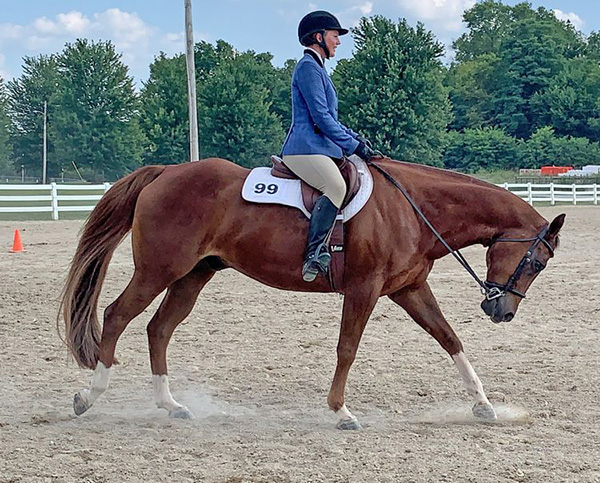
Defining Horse Jargon Terms- Movement
Michigan State University Extension
By: Taylor Fabus
In this article series from Michigan State University Extension, we explore a variety of often confusing horse-related terms. In previous articles, we have covered beginner riding terms, advanced riding terms, tack and equipment and common misspellings, and horse sale terms. In this article, we’ll delve into the complex world of horse movement. You’ll often encounter these phrases being used when describing or evaluating a horse’s movement. If you find this content especially interesting, you may want to explore competitive horse judging, where evaluating movement is explored in great detail. The terms described below are advanced and complex to define, and even more complex to put into practice while riding or training.
Stride length
No matter the discipline, it is more ideal for a horse to have a long stride. In all types of performance, longer strides are preferred over shorter strides. While this isn’t necessarily a judge’s first priority, it is certainly taken into consideration in the evaluation process. A horse with longer strides will cover more ground with less steps, in theory being more efficient and tiring less quickly.
Cadence
Similar to its meaning in music, cadence refers to the rhythm of a horse’s hoof beats. Each gait that a horse performs (walk, trot, canter, etc.) will have a specific footfall pattern. No matter the discipline or gait, you want a horse to have a consistent, even cadence. Not only will this be an indicator of athleticism and soundness, but also level of training and focus. A horse with a steady cadence will likely also maintain a more consistent pace and be more pleasurable to ride.
Collection
Collection is an indicator of many things, not the least of which is a horse properly using its body to perform an athletic task. Achieving collection is one of the most difficult skills and must be developed over months and years and is often easier for a more seasoned horse. Collection while traveling involves the horse being lifted in its shoulders and at the same time engaging the use of its hind end joints and muscles to propel itself forward. Another symptom of collection is a horse with a topline that appears somewhat rounded from its withers all the way to its tail, with the highest point of the curve being the back.
A horse that lacks collection will have a flatter topline, or even concave with the back appearing dropped. Some other terms that may be associated, or used in conjunction with collection, are impulsion (referring to the amount of engagement from the hind quarters that’s propelling the horse forward), drive (again referring to engagement of the hindquarters, and lift (referring to a horse being lifted in their shoulders and back).
Behind the bridle
A horse that is described as behind the bridle means that its chin is held too closely to its chest, giving the appearance of either intimidation or resistance to the bit. Ideally, a horse’s face will be held perpendicular to the ground with any excessive deviation from that not being ideal.
On the forehand
This is referring to a horse that lacks collection and is placing more weight on its front end than its hind end. This horse may appear to be traveling downhill, hitting the ground harder with its front feet. Furthermore, a horse that is heavy on its forehand will lack ideal engagement of the hindquarters. You can imagine if a horse is asked to perform a difficult athletic task, such as jumping a fence, it would be more difficult for a horse that is traveling heavy on its forehand. A horse that is on the forehand is also more likely to trip and stumble as it travels.
Self-carriage
A horse that exhibits a great amount of self-carriage likely has a great amount of natural ability or has had a great amount of training. This horse has the ability to hold its frame, collection, impulsion and lifted forehand with little assistance or interference from the rider. This horse will also likely have a consistent cadence. In order to exhibit self-carriage, a horse would not necessarily need to have a long stride, though.
Another excellent resource new horse owners may want to consider is the free, online course Purchasing and Owning a Horse 101 from My Horse University.
This article was published by Michigan State University Extension. For more information, visit https://extension.msu.edu. To have a digest of information delivered straight to your email inbox, visit https://extension.msu.edu/newsletters. To contact an expert in your area, visit https://extension.msu.edu/experts, or call 888-MSUE4MI (888-678-3464).
Recently Added
- More Around the Rings with the G-Man — 2025 Florida Gold Coast January 1, 2026
- EC Photo of the Day: 2026 is the Year of the Horse January 1, 2026
- Around the Rings – 2025/2026 Arizona PHC Copper Country POR December 31, 2025
- 18 New APHA Rules in Effect January 1, 2026 December 31, 2025
- All That You Love Plus More at the 2026 Sun Circuit December 31, 2025
- More Around the Rings – 2025 Florida Gold Coast & Florida PHC Ugly Sweater Extravaganza December 31, 2025
- EC Photo of the Day: New Year’s Eve 2025 December 31, 2025
- Happy New Year 2026! A New Year’s Show Story by Publisher Tom Grabe. December 31, 2025
- Around the Rings with the G-Man — 2025 Florida Gold Coast December 31, 2025
- Around the Rings – 2026 Florida PHC Ugly Sweater Extravaganza December 30, 2025
Archives
Sign In
Equine Chronicle ® All Rights Reserved. Copyright © 2026
4727 NW 80th Ave. • Ocala, FL 34482 • 352 369 1104 • FAX 352 369 1521
Privacy Policy | Questions, please contact The Equine Chronicle
-










